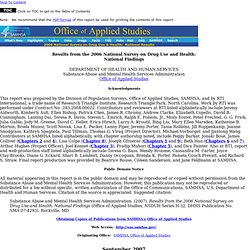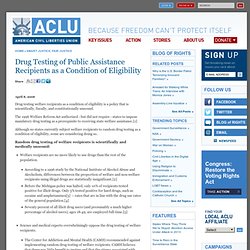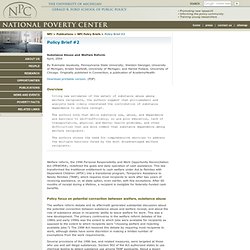

Mass Extinction Underway. Human beings are currently causing the greatest mass extinction of species since the extinction of the dinosaurs 65 million years ago. If present trends continue one half of all species of life on earth will be extinct in less than 100 years, as a result of habitat destruction, pollution, invasive species, and climate change. (For details see links below.)
This website began on April 22, 1998 with the posting of the article below. (The article is still here to provide historical context.) Following the article are more than 300 links to recent authoritative reports and updates about the current mass extinction. Results from the 2006 NSDUH: National Findings, SAMHSA, OAS.
Note: We recommend that the PDF format of this report be used for printing the contents of this report.

This report presents the first information from the 2006 National Survey on Drug Use and Health (NSDUH), an annual survey sponsored by the Substance Abuse and Mental Health Services Administration (SAMHSA). The survey is the primary source of information on the use of illicit drugs, alcohol, and tobacco in the civilian, noninstitutionalized population of the United States aged 12 years old or older. The survey interviews approximately 67,500 persons each year. Unless otherwise noted, all comparisons in this report described using terms such as "increased," "decreased," or "more than" are statistically significant at the .05 level. Illicit Drug Use In 2006, an estimated 20.4 million Americans aged 12 or older were current (past month) illicit drug users, meaning they had used an illicit drug during the month prior to the survey interview. Press Release - NIAAA Researchers Estimate Alcohol and Drug Use, Abuse, and Dependence Among Welfare Recipients - 10/23/96.
Drug Testing of Public Assistance Recipients as a Condition of Eligibility. April 8, 2008 Drug testing welfare recipients as a condition of eligibility is a policy that is scientifically, fiscally, and constitutionally unsound.

The 1996 Welfare Reform Act authorized - but did not require - states to impose mandatory drug testing as a prerequisite to receiving state welfare assistance.[1] Although no states currently subject welfare recipients to random drug testing as a condition of eligibility, some are considering doing so. Random drug testing of welfare recipients is scientifically and medically unsound: Welfare recipients are no more likely to use drugs than the rest of the population. Random drug testing of welfare recipients is fiscally irresponsible: Drug testing is expensive. Random drug testing of welfare recipients is likely unconstitutional under both the U.S. Michigan is the only state to attempt to impose drug testing of welfare recipients – a policy that was struck down as unconstitutional in 2003. . [3] Brief of Plaintiffs-Appellees, Marchwinski v. National Poverty Center. Substance Abuse and Welfare Reform April, 2004 By Rukmalie Jayakody, Pennsylvania State University; Sheldon Danziger, University of Michigan; Kristin Seefeldt, University of Michigan; and Harold Pollack, University of Chicago.

Originally published in Connection, a publication of AcademyHealth. Download printable version. (PDF) Should Drug Testing Be Mandatory For Welfare Recipients? People support mandatory drug tests for welfare recipients.